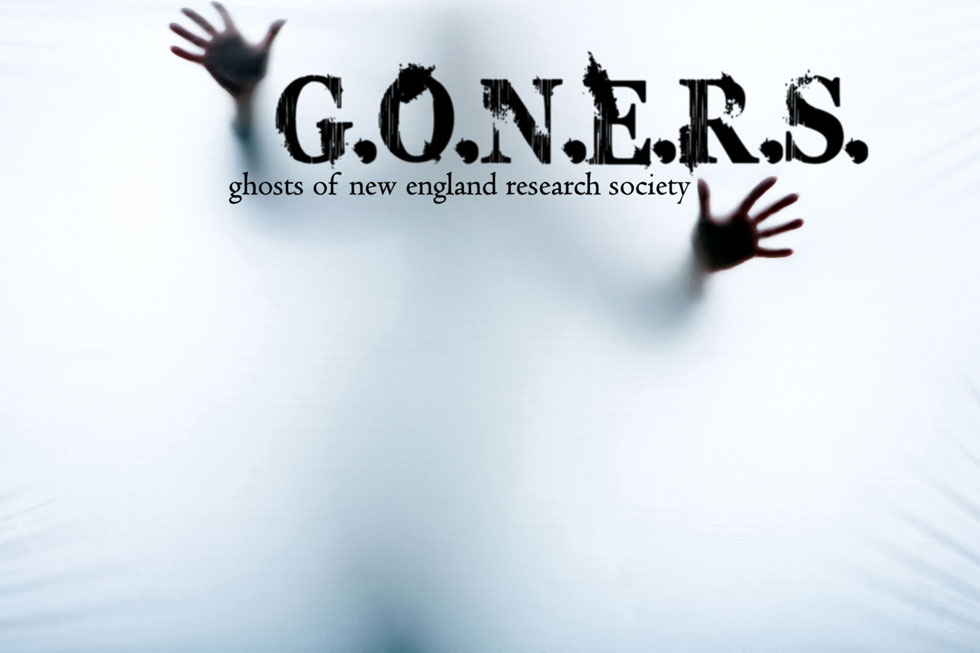The Haunting of the Italian House
Driving along the Main St., of a quaint New England village, past the Town Green with its bronze and granite memorials to local heroes; residents killed in past wars, after the Town Gazebo and the flag pole, along the row of large, evenly spaced, Federal, Greek Revival and New England, "Salt Box" style homes, sits in all its ostentatious spender; the Italian House. Labelled so by local residents shortly after it was built in the late 1870s by an Italian immigrant, Sebastian Milardo, who had succeeded in his American dream and amassed substantial wealth.
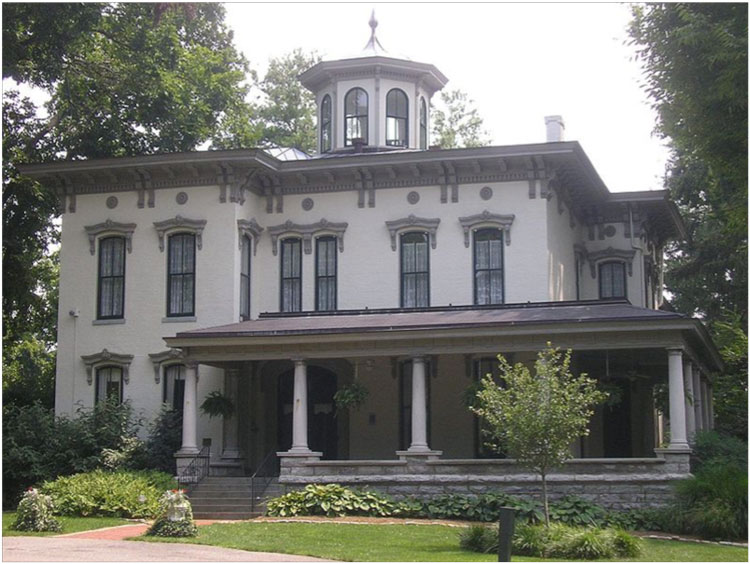
The house remains one of the premier representations of the late "Victorian," or Guilded Age 'Italianate" style in New England. At three full stories, the interior is nearly 15,000 square feet. (Picture used for illustration only.*)
Today, no one remembers why Milardo returned to Italy shortly after the completion of the house. Some believe it was because of the not so subtle discrimination Italian immigrants faced during that period. The descendants of earlier British and Swedish immigrants did not take kindly to the new wave of Italians coming to America's shores after the Civil War. Some speculate that Milardo's house was a, 'thumb in the eye' to his neighbors. Indeed, he did have the house painted a brilliant, purplish, grape color that was impossible to avoid seeing when anywhere on Main St. Milardo called his home, "Casa D'uva," house of grapes, although not one grape arbor was erected nor one grape vine ever grew on the expansive property. The longtime residents of town, without a doubt, called it many things but the name that stuck is, "The I-talian House," with purposeful emphasis on the, "I."
The next owner of the house was a wealthy industrialist, who made bad investments and lost his fortune, as well as the house, in the economic decline of the late 1800s. His residency in the house was less than one year.
The property then passed to a well to do Gentleman Farmer, Osbourne Coe, a member of the local agricultural gentry, who repainted the house in a more subtle color as it remains today. Coe was a social butterfly and well connected in local, state and even national politics. He turned the Italian House into a showplace of central Connecticut. Dignitaries were often in attendance at the lavish parties which carried on nearly every weekend during the social season. Samuel Clements, more commonly known as Mark Twain, often made the trip from his home in Hartford to visit his friend. Governors and even a former President were seen coming and going and often, 'lawn bowling', a favorite pastime of Coe. The local library has many old newspaper stories about the love Coe had for his home, the joy he took in entertaining, and his many famous guests.
In 1899, Coe died of pneumonia at the age of 63 in the master bedroom of his beloved home. He was estranged from his family and cut every one of them out of his substantial estate. Because of this, his funeral was small and private. He is buried in a nearby town under a modest headstone.
The Woman's Relief Corps was heir to the house and took control of it in 1900. Because of its enormous size and multitude of rooms, it was easily made over into a home for indigent Civil War Veterans. This act was a seminal event in the care of homeless and troubled veterans and pointed the way to future developments in this field. As the veterans aged and passed away in the beginning years of the 20th Century, the house gradually became a general nursing home for the aged and infirm. A psychiatric ward of sorts was established on the third floor and although that ward is long gone, wall restraints and other devices are still in evidence of that sad era when the treatment and care of the mentally ill consisted of little more than a cruel and hopeless incarceration.
The 1950s brought new life to the area and a modern nursing home was built on the property, immediately adjacent to the old house. The new facility grew over the years until today, it is able to accommodate over 200 full time residents who require skilled nursing.
Although the exterior of the Italian House was well maintained by the owners of the nursing home as part of the town Historic District, it sat empty and largely unused for the next 60 years. Part of the old house; the grand dining room, which had been the scene of so many lavish events during the Coe years, was used as a storage area for wheelchairs and orthopedic equipment. Nurses and orderlies from the new facility had a decided dislike for going alone in the Italian House to retrieve equipment. Rumors began to circulate that shadows would move past them, often voices and footsteps could be heard when no one was nearby. Several nurses flatly refused to go in the house at all after a few terrifying experiences of reportedly having their hair pulled. One nurse ran out of the house, got in her car, sped from the parking lot and never returned to work. When asked by a friend what had happened, she refused to talk about it. Although the storage space was severely needed, the management was facing a mutiny and to make matters worse, residents of the new facility were now reporting seeing the apparitions of people in the 3rd floor windows of the old house; the location of the old psychiatric ward. It was decided to build a metal storage building in the rear of the nursing home to house excess equipment so employees would not have to enter the old house.
This new arrangement worked well until the nursing home and Italian House were sold to new owners in 2010. The new owners, who also owned several other facilities, saw an opportunity to turn the Italian House into their corporate offices because of its enormous size and geographically centralized location in the state. A contractor's survey of the Italian House revealed that although the exterior and roof had been maintained in excellent condition, electricity had been cut off years before and electricians were needed to wire in circuits to immediately install smoke detectors. Fear of fire was a major concern to the new owners because the old house stands so close to the new facility.
Things began to go wrong from the first day the electricians entered the Italian House. Tools were disappearing and then would later turn up near the front door. A few of the men thought a new man on the team was playing jokes and despite his fervent denials, a fistfight almost erupted. The electricians reported hearing strange moaning sounds and footsteps coming from the 3rd floor and several refused to go up there. They said that their ladders would begin to shake for no apparent reason the moment they stepped on them. One man's pants were even pulled down to his ankles as he climbed the ladder. The foreman of the electricians had planned on having the smoke detectors installed within three days. It was now over a week since they started and were behind schedule because various members of the crew were calling in 'sick' every day. The foreman was under pressure from his boss to finish the job because it was taking so long to complete, any profit was quickly dwindling. The foreman made the decision to go into the house with one other man after hours and finish the work. He regrets that decision to this day. With the last of the smoke detectors installed on the third floor, the foreman's helper complained of feeling a strange burning sensation on his back. Lifting up his shirt to ask the foreman what he saw, the foreman observed three long, bleeding scratches on the man's back from his neck to his belt. The two fled the house as quickly as they could gather their tools.
The Investigation
Ghosts of New England Research Society (G.O.N.E.R.S.) was contacted by the owners of the nursing home and Italianate house in October 2010.
We had a lengthy meeting with the owners in which we learned the details of the suspected paranormal happenings in the house and were filled in on its long and sometimes lurid history.
The owners had repeatedly stressed two points during our interview; first, they wanted answers to the questions: "Is the house really haunted and if so, will it ever be safe to convert it to offices and have employees work there?" Secondly, they stressed the need for absolute secrecy about the investigation and results. After all, who would place their loved one in a nursing home immediately adjacent to a known haunted house?
We assured them of complete discretion and my daughter Melanie and I set about preparations for the investigation. Coincidentally, the first open date we had was on Halloween.
We entered the huge, darkened, old house at 6:00 pm on Friday, October 30, 2010 and were locked in by a custodian. We proceeded first to the magnificent dining room. Our flashlights revealed that the huge, gas lit chandelier was still attached to the vaulted ceiling and looked like it had not been lit since Osbourne Coe owned the house. Now it was covered in cobwebs. Only a few minutes later, something or someone, touched my left forearm, rather firmly. Looking around to see if I brushed up against something, I was satisfied I had not. Then it occurred to me that I have a "U.S.M.C." tattoo on that exact spot, a relic from my Marine Corps days. Could it be that since this had been a home for Civil War Veterans, many of whom had died here, one of them had recognized the emblem and was making contact?
We proceeded into room after room on the 1st floor, with night vision cameras and recorders running. In one room, as we entered, we clearly saw a black shadow figure, dart from a corner of the room as if we had surprised it and then out of the opposite door. Footsteps were heard walking up and down the central staircase and although we looked several times, we never saw anything causing them. As we entered another room on the first floor, we both distinctly felt fingertips running across our faces. I wanted to rule out that it might be cobwebs and shined a flashlight on Melanie's hair to see if any were in evidence. There were none there.
Although both of us are seasoned paranormal investigators, we were already somewhat overwhelmed with the amount of activity we were experiencing. I was only half joking when I said, "This is like a spooky, carnival, haunted house."
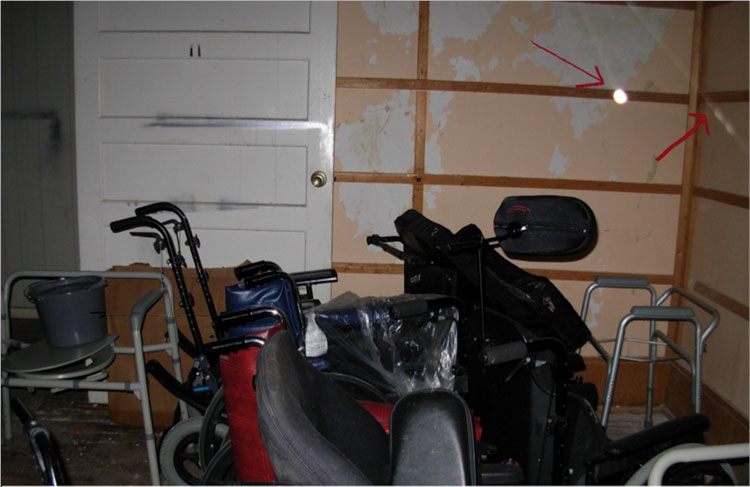
Photo courtesy of a former employee who capturted this fast-moving ball of light when the house was used for storage.
On several occasions during our investigation, we saw self-luminescent balls of light flying in a corkscrew pattern along hallways and zooming in and out of rooms. This confirmed some of what we had been told by former staff, one of whom was kind enough to share this picture.
While on the 3rd floor, we heard a thud from downstairs. When we later descended the stairs, we found a rather large, 8"x8" piece of plaster, smashed on the landing. We could not find anywhere that it might have come from.

We bypassed the 2nd floor for now and proceeded to the former psychiatric ward on the 3rd. We had brought an old Civil War hat called a Kepi, as a trigger object and left it on the floor with a digital recorder running while we descended and waited in the 2nd floor bedroom of Osborne Coe. Thirty minutes passed as we sat nearly motionless, not speaking and then we heard the footsteps on the 3rd floor. Just then, there was a loud, metallic crash at our feet. I flicked on a flashlight and saw a brass disc on the floor, still spinning like a coin will do when dropped. Melanie, somewhat irritated that an object had been thrown at us, shouted the question:
"Who threw that?"
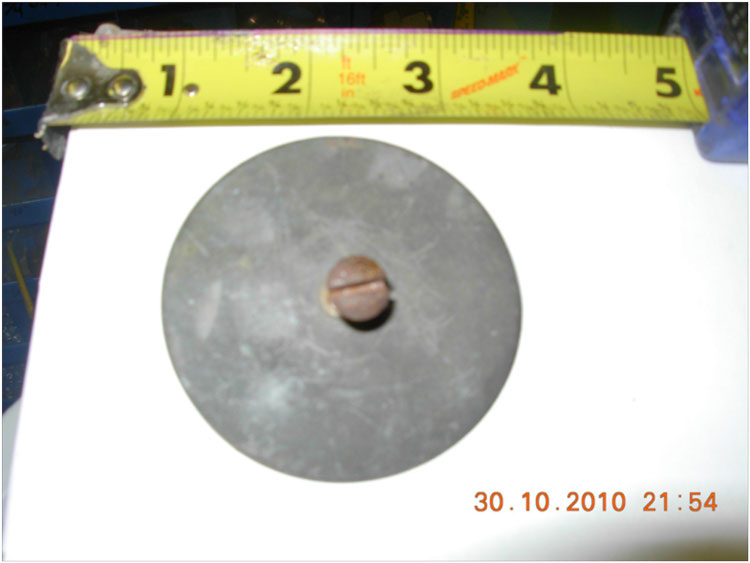
We didn't hear the response audibly at the time. It was only later when we were reviewed our recordings, we clearly heard:
"Osbourne Coe."
Proceeding up to the 3rd floor we recovered the hat and recorder. The recorder had been placed on top of the hat, it was now on the floor next to it. Immediately, we played the recorder and were able to clearly hear the footsteps walking up to the hat, then turning and walking away.
We moved to another room on the 3rd floor and began an EVP session. We noticed a large light bulb in the closet of the room, it looked very old as if it was from the 1930s.
We believed we had sufficient evidence to present to the clients and we talked about how we should wrap up our investigation. We started down the stairs when a loud crash of glass breaking came directly from the room we had just exited. I thought at first a window had been blown out by some unknown force. We cautiously re-entered the room and saw the windows were intact, however, the large light bulb that we had observed in the closet was now smashed in the center of the room. Something had unscrewed it from the fixture in the closet and apparently thrown it at least 10 feet where only fragments of glass and the metal base now lay.
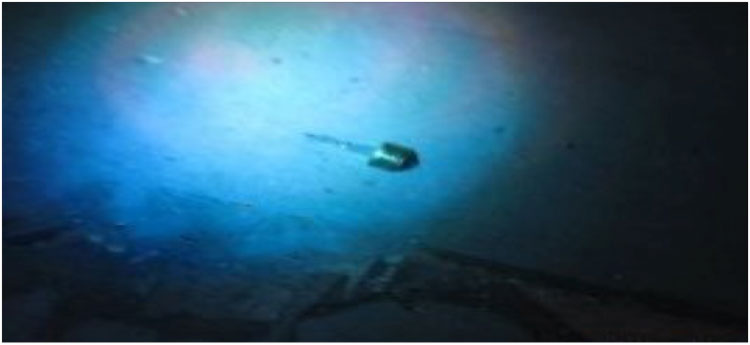
With things being thrown at or near us, we realized this was becoming dangerous and we should call it a night. Never before in all of our investigations had we witnessed so much paranormal activity in one location.
Our recommendations to the owners of the home were clear and concise. After presenting our evidence and detailing our experiences, we told them in no uncertain terms:
"Seal the building and never, under any circumstances, let your employees in there."
They took our advice. Today, the beautifully maintained outer shell of the Italian House keeps the secret of the haunting that lurks within.
*The picture on the title page is of a very similar house, used to illustrate the story. For privacy reasons, a picture of the actual house has not been used.
